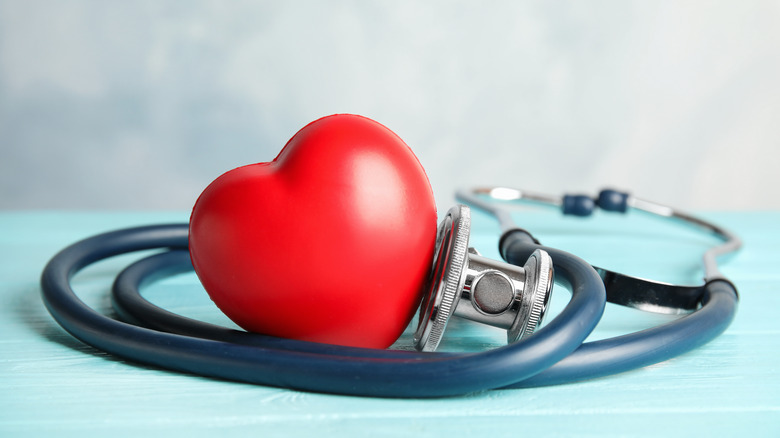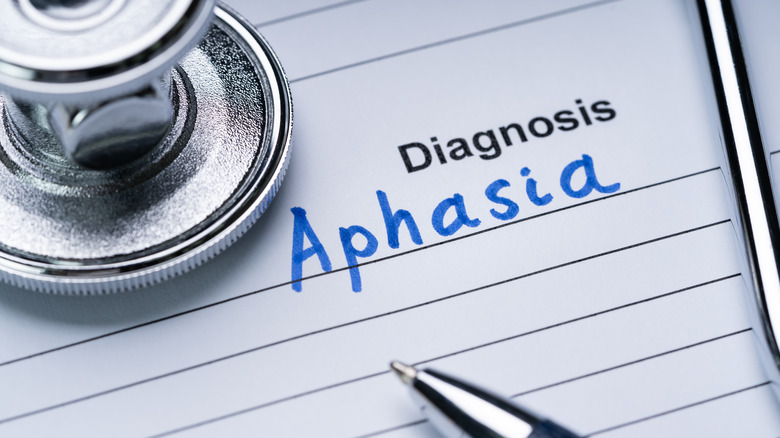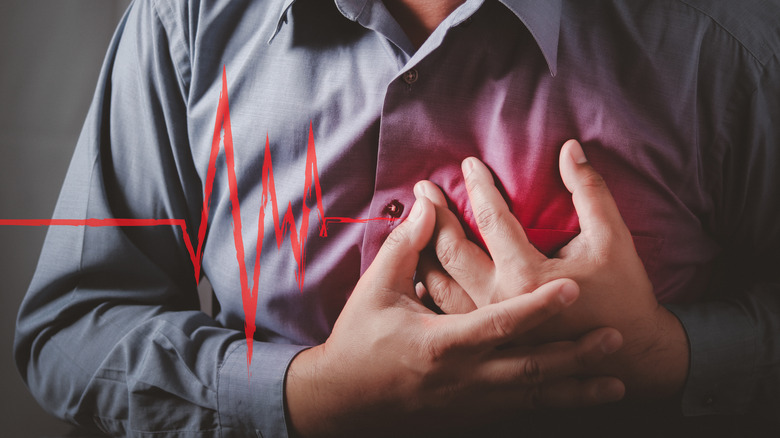Warning Signs Of Blood Clots You Should Never Ignore
Let's be clear: Blood clots aren't always bad. As the National Institute of Health (NIH) explains, blood clots can act like natural bandages for injuries both on the surface of your skin and inside your body. But this is where potentially serious health problems could begin.
Like your skin, the walls of your blood vessels can become injured, so blood clots can form inside those vessels (although they sometimes form without an injury occurring). Usually, these clots are harmless — unless they don't eventually dissolve. Think of this way: Normally, the water in a river flows without causing major problems, but when some of that water freezes into chunks of ice, that ice can cause damage. Similarly, blood clots that don't dissolve might get moved along by your circulatory system to other areas of the body and do harm. And just like how large enough ice chunks can obstruct the flow of a river, Johns Hopkins explains that stationary blood clots can block or partially block arteries and veins.
The bottom line is that blood clots can be dangerous. So, it's important to keep in mind that the following are just some of the possible red flags of blood clots, along with examples of how they might connect to some blood clot-related health problems. However, the human body is complex, so don't try to self-diagnose yours or someone else's condition. As the NIH recommends, if you suspect you have a blood clot, seek medical help immediately.
Swelling in the legs
Imagine you have a friend who is complaining about how one of their legs is larger than the other. You ask if they might have injured themselves or pulled a muscle during a workout, but they insist they haven't. Unfortunately, according to the Mayo Clinic, that swelling in your friend's leg could be a sign of a condition called deep vein thrombosis or DVT.
Remember, blood clots can form and stay stationary inside of your blood vessels, including your deep veins (like the ones located in your legs). If this happens, then you might notice swelling in just one leg. Appearances aside, however, DVT is never something you should ignore. Just because the blood clots involved in DVT are stationary doesn't mean they can't eventually break away from the blood vessel's wall and travel to other areas of the body. In fact, it's not uncommon for DVT blood clots to wind up traveling to the lungs.
Although swelling is a typical sign of DVT, it's possible to have a DVT and not experience any symptoms. However, there are certain risk factors that might increase one's chances of developing blood clots in their deep veins. These include having other medical issues like ulcerative colitis and Crohn's disease. Also, jobs where someone sits for hours a day rather than moving around increase the chances of developing this condition.
Pain in the chest
What is the first thing that would pop into your mind if you saw someone clutching their chest in pain? For many, they would immediately be concerned the person was having a heart attack. However, chest pain can also be a sign of blood clots affecting one's lungs.
According to the Mayo Clinic, blood clots can form in deep veins like the ones in the legs. When this occurs, the clots can eventually break off, allowing the circulatory system to carry them to other areas of the body. When these clots make it to the lungs, they can obstruct blood flow in your pulmonary arteries and cause a condition called pulmonary embolism or PE. As a result, you might experience sharp pain, especially when you take a deep breath or cough. Additionally, that pain might occur when you stoop down or bend over. And yes, it can feel similar to a heart attack.
Besides possibly damaging the lungs, PE can also put a strain on one's heart. This is because the heart might pump harder to compensate for the blood clots obstructing the blood flow in your lungs' blood vessels. Besides the extra pressure this puts on one's heart, it can also raise one's blood pressure. And one more thing to keep in mind: Although blood clots from deep veins in the legs could cause PE, technically PE can develop because of blood clots from other areas of the body.
Abdominal pain
Before we get into this next symptom, it's time for a little biology 101. Of course, your circulatory system has veins that go throughout your body, but as Healthline explains, the superior mesenteric vein, the inferior mesenteric vein, and the splenic vein are the ones that take care of your intestines. And as you can imagine, a blood clot in any of these veins can lead to pain in your abdomen.
Now to be fair, this medical condition, which is called mesenteric venous thrombosis, is not common. And abdominal pain can occur for many reasons that have nothing to do with your circulatory system. With that said, there are a couple of telltale signs that pain could be occurring because of mesenteric venous thrombosis. For one, abdomen pain that's connected to blood clots typically happens after someone eats. Also, as nurse practitioner Caroline Sullivan told Healthline, this pain might also get progressively worse. In other words, the abdominal discomfort someone has when they first develop mesenteric venous thrombosis might be less severe than the pain they experience after they've been living with the condition for a while.
Unfortunately, mesenteric venous thrombosis can eventually severely damage your intestines. In some cases, a person with this condition might need to have part of their intestines removed. Others might need a colostomy or ileostomy bag instead of using the bathroom.
Cramp-like pain
Anyone who's attended spin class will probably tell you that leg cramps, especially in the calves, are just part of the experience (especially if you're new to this form of exercise). And while cramping can be unpleasant, according to GoodRX, it's usually not something to worry about. That is, unless it's technically not a cramp, but a blood clot.
Leg cramps or charley horses are usually because of spasms in your muscles. Unfortunately, blood clots forming in the deep veins in your leg — known as deep vein thrombosis or DVT — can create a similar painful sensation. Technically, if you're experiencing pain in one of your calves, it could be either a cramp or a clot. Fortunately, while the pain can feel similar, there are some common key differences. Cramps usually start out bad but gradually begin to feel better. DVT usually is the opposite, beginning as mild pain and then becoming more intense. Also, cramps tend to happen all of sudden, which is usually not the case with DVT-related pain.
Besides monitoring your leg pain, you may also want to ask yourself if any factors could be causing cramps in your leg. For example, not having enough magnesium or potassium in your body can make your leg muscles cramp. Plus, certain medications used to treat health issues like asthma could also cause charley horses. Regardless, if you even suspect a blood clot could be behind leg pain, seek medical help right away.
Redness and warmth
When you have a blood clot in a deep vein (like the ones in your legs), it can cause a number of symptoms like noticeable swelling, according to Medical News Today. But it can also change how your skin feels and its general appearance.
Blood clots that are located in deep veins can make the skin look discolored or reddish. But beyond that, the skin might also be warmer than the skin covering other areas of the body. Of course, blot clots aren't the only reason someone might experience these symptoms. A sunburn, for example, can change the temperature and appearance of skin. However, if a person has pain and swelling (especially if it's only in one leg) and the skin on that part of their leg is discolored and warm, then they might be experiencing deep vein thrombosis (a.k.a. blood clots in their deep veins).
Fortunately, there are some simple tricks that help you reduce the chances of developing blood clots — and one of them is something you can literally do in your sleep. If you elevate the foot of your bed four to six inches, you're less likely to experience blood clots. You also might want to stop crossing your legs and start wearing compression stockings. In addition, high salt intake can raise the odds of developing blood clots, so you might want to start tracking how much sodium you consume.
Breathing issues
Think about the last time you had a bad case of the flu. Chances are your lungs felt congested, so you had some difficulty breathing normally. Unfortunately, there are quite a few ailments out there that can affect your lungs. But if you're experiencing breathing issues, it could also be because of blood clots in your lungs.
Keep in mind that sometimes, a blood clot can move from the deep veins in your legs to the blood vessels in your lungs, according to the University of Chicago Medicine. This condition (known as pulmonary embolism or PE) can be severe and may lead to breathing problems, including shortness of breath. And if a blood clot in the lungs is large enough, a person might develop submassive PE. This condition not only affects their breathing, but also causes their oxygen levels to drop. Even if a large clot breaks apart, those smaller clots can clog or partially clog up multiple areas of the lungs.
While anyone could develop PE and experience breathing issues, your odds go up if you have certain medical concerns. And as the Cleveland Clinic explains, these include HIV/AIDS and inflammatory bowel syndrome. Additionally, cancers and some of the medicines used by cancer patients can increase one's chances of having blood clots in the lungs. Also, you'll want to avoid "economy class syndrome," where you remain seated on an airplane for a long amount of time without getting up to stretch your legs.
Coughing up blood
One way that medical dramas on TV quickly convey that a patient is getting worse is by having them cough up blood. And this makes sense since coughing up blood is a symptom of a number of medical issues, including pulmonary embolism or PE.
As the Cleveland Clinic points out, coughing in general is a possible sign of PE (a blood clot or clots in the blood vessels in the lungs). And fair warning, we're going to talk about something disgusting now. When a person has PE, they might not only cough up sputum or mucus, but also mucus mixed with blood. However, as WebMD states, coughing up blood (which is known medically as hemoptysis) is also a potential red flag for lung cancer, bronchitis, chronic obstructive pulmonary disease or COPD, pneumonia, non-cancerous tumors in the lungs, and tuberculosis. And those are only the ailments directly related to your lungs. Hemoptysis can also occur if someone has lupus, a parasitic infection, or congestive heart failure.
The point is if you're coughing up blood, your body could be warning you about a potentially serious medical issue, including a blood clot (or blood clots) obstructing your lungs' blood vessels. Per the Cleveland Clinic, PE can be lethal, so it's important to seek medical help right away. Remember, a health care professional has access to tests like CT scans, ultrasounds, and MRIs, all of which can help them determine if you have PE.
Numbness and weakness
Did you know that there are two types of strokes? According to MedlinePlus, a hemorrhagic stroke occurs when an artery or a vein ruptures, and the brain becomes overwhelmed with blood. However, as a separate MedlinePlus article points out, a stroke can also happen when the reverse situation takes place, and blood clots obstruct a blood vessel from sending blood to and from the brain. This is known as an ischemic stroke, and like a hemorrhagic stroke, it can cause numbness and weakness.
A stroke that is caused by blood clots can affect multiple areas of your body. Specifically, you might find that one of your arms or legs feels weak or numb all of a sudden. Additionally, you might not be able to walk normally and have trouble maintaining your balance. And if this weakness or numbness affects only the right or the left side of your body, that can be a major red flag that you're experiencing a stroke. Furthermore, you might experience that numb or weak sensation in your face.
Regardless, if blood clots are the culprits behind a stroke, it's crucial to seek medical help right away. As MedlinePlus explains, a stroke can cause long-term damage, including memory issues, difficulty with moving, emotional problems, and ongoing pain. However, the exact fallout of a stroke varies, depending on which area of the brain was affected.
Trouble speaking
Since a stroke (including the kind caused by blood clots) can affect different areas of your brain, it can cause a variety of symptoms, including problems talking. As WebMD explains, when a blood clot deprives your brain of oxygen, it can make one's speech slurred. In some cases, it can even take away the person's ability to talk. But while some people might only experience speech issues during a stroke, it is possible for the brain to be damaged severely enough that they develop a language-related condition called aphasia.
According to WebMD, if a stroke patient develops aphasia, they could repeat themselves when they speak or find it difficult to come up with the words they want to say to best express themselves. They also might have trouble understanding what someone is telling them, even though aphasia doesn't affect one's intelligence. In fact, these symptoms can be red flags of a particularly severe form of aphasia called global aphasia that usually happens following a stroke. And beyond affecting the way one communicates verbally, aphasia (including global aphasia) can also negatively impact someone's ability to write and read.
Although aphasia can be life-altering, therapy can help even the most severe forms of it. A speech-language pathologist, for example, can help by working with a stroke patient to help them improve their verbal and non-verbal communication skills.
Vision changes
Imagine this: Your friend tells you that they're worried about their vision. They explain that they woke up one morning with blurry vision, but only in one eye. Their only small comfort is they aren't in pain, so they're hoping that it means this is nothing serious. Unfortunately, your friend should actually see an eye doctor right away, because a blood clot might be affecting their eyesight.
As Healthline explains, your retina is at the back of your eye, and is crucial for your vision. That's because it turns the light that enters your eye into signals, which then go to your brain. And your eyes need a network of both main and branch arteries and veins that supply blood to and away from their retinas. But when a blood clot obstructs the blood flow to or from the retina, that can cause blurriness and even vision loss in the affected eye. And even though a person might not feel pain because of a blood clot affecting their retina, that doesn't mean this isn't a potentially serious condition.
While it's possible to regain your eyesight if it's altered due to a blood clot affecting your retina, permanent damage is still possible. But there is something you can do to increase your chances of fully recovering: Seek medical help right away. In fact, if you lose your eyesight in one eye, you should treat that as an emergency and call 9-1-1.
Headaches
Now, don't panic. Headaches are very common and not necessarily dangerous. But as the Premiere Neurology & Wellness Center explains, they can also be a symptom of either a hemorrhagic or an ischemic stroke. And remember, ischemic strokes occur because of blockages (like blood clots) in the blood vessels, according to MedlinePlus. Unfortunately, it can be difficult to tell if a headache is happening because of a stroke.
One important thing to remember is that a headache from a stroke doesn't only happen in one area of the head. For example, one person could have a headache because of a stroke and experience pain on the back of their head, while another person could have a stroke and feel pain in their forehead. This is because the area that's in pain usually corresponds with specific blood vessels that circulate blood to or away from that part of the brain.
In addition, it's also not uncommon to confuse a migraine for a headache that occurs because of a stroke. But while stroke-related headaches come on suddenly, the pain from a migraine increasingly gets worse. Also, migraines have other symptoms besides pain (like tingling skin or auras). Headaches that happen because of a stroke usually lead to loss of sensations. But let's be clear: Self-diagnosing yourself or someone else can be dangerous, so don't be afraid to seek medical help.
Dizziness
Feeling dizzy or lightheaded is not an uncommon symptom for a number of medical concerns. That said, it can also happen for reasons that have nothing to do with health issues. After all, just watching something spinning can create a dizzying feeling. But as Verywell Health points out, the culprit behind dizziness can be blood clots.
According to the Texas Heart Institute, feeling dizzy all of sudden can be a red flag that not only do you have a blood clot, but it also could be causing enough problems with your circulatory system that you're in danger of having a heart attack. In addition, dizziness is also a warning sign of a stroke, per the American Stroke Association. And remember, while they're not the only reason someone might have a stroke, blood clots can be the culprits behind this potentially life-altering medical emergency.
Besides a stroke, the Mayo Clinic says dizziness can be a sign of a transient ischemic attack. Also known as a "mini stroke," a transient ischemic attack or TIA involves blood not flowing normally but only causing temporary damage to the brain (via the Premiere Neurology & Wellness Center). Nevertheless, a TIA is serious, and dizziness can be a major red flag of health problems. So if you or someone you know has dizzy spells, contact a medical professional.
Problems urinating
Okay, this next possible symptom of blood clots can be a little embarrassing to talk about, even with a health care professional. But when it comes to your health, you sometimes need to open up about uncomfortable topics. Case in point, the symptoms of blood clots that affect your kidneys.
Most of us probably know we have two kidneys, but as Healthline explains, we also have two veins called renal veins that help to circulate blood away from our kidneys. However, when a renal vein has a blood clot (or worse, if both do), then a person can develop a condition called renal vein thrombosis or RVT. When this occurs, a person might produce less urine than normal. They also might have blood in their urine for no apparent reason. For example, a woman experiences blood as a part of menstruation, but RVT is something separate from her menstrual cycle.
In addition to changes concerning urination, a person might also experience pain in their lower back because of RVT. And just like a blood clot can travel from one area of the body to another, a blood clot in either of the renal veins could be circulated to the lungs. So, besides being aware of the possible symptoms of RVT, you also should keep in mind factors that can increase your chances of developing this condition. These include injuries to your kidneys, abdomen, and back, oral contraceptives, being dehydrated, and tumors.
Faster heart rate
Someone might say "my heart skipped a beat" when they describe falling in love. But as the University of Michigan Health points out, changes in heart rate could be a warning sign of a blood clot-related issue called pulmonary embolism (PE).
Remember, PE can happen when a blood clot or clots obstruct blood flow in the blood vessels in one or both of the lungs, and as the University of Michigan Health notes, symptoms can include heart palpitations. And just to clear up any possible confusion, palpitations are when you notice that your heart is either beating at an irregular rate or is beating faster than normal. So if your heart is flip-flopping, fluttering, racing, and has either too many or not enough beats, then you might be experiencing the effects of a blood clot.
In addition, heart palpitations can make you feel like your heartbeat is coming from your neck instead of your chest. But that's not the only possible neck-related issue connected to blood clots. As the American Heart Association explains, neck pain can be a sign of both PE and a heart attack. Bottom line, if something seems off about your health even in just a small way, speak up about it. Remember, health care professionals have the training to analyze symptoms like heart palpitations and can help you make the best choices for your overall health.















